I like to make functional art: All of my projects are made to be used. Every day since 2006, I drink tea from one of the first mugs I made. My projects include careful planning and execution to get exceptional items that will last for years to come. If you want something you don't see, just ask: I can make quotes and provide computer mockups of projects.
Think of everything on this site as examples: The actual options are endless.
I can generally do most finishes, but the ones I do most often are:
- Shellac
- My favorite finish to use in general. A high-gloss coat: it really brings out the character in the grain of the wood. It also cures much faster, leading to a faster delivery time on projects.
- Polyurethane
- Also a high gloss coat, this is more durable and water-resistant. I use it on the outside of drinking vessels since they will come into contact with water.
- Wax
- One of the fastest finishes to use. I use wax for a few different things:
- Buffing other finishes
- Finishing on interlocking puzzles or sliding box rails to prevent sticking.
- Finishing on the inside of boxes where durability isn't as much of an issue and/or a slightly sticky finish may not be desired.
- Pour-on polymer finish
- A two-part epoxy finish, this is the best for holding liquids in drinking vessels.
These woods are readily available to me locally and I usually have them on hand. These are also the cheapest options.
 White Ash
White Ash Wood Database Entry for White Ash Color/Appearance: Beige to medium brown color. Grain/Texture: Has a medium to coarse texture similar to oak. The grain is almost always straight and regular One of the common uses for Ash is to make baseball bats. Next to other woods, White Ash appears fairly white, making a good contrast
 Aromatic Red Cedar
Aromatic Red CedarWood Database Entry for Aromatic Red CedarColor/Appearance: Heartwood tends to be a reddish or violet-brown. Sapwood is a pale yellow color, and can appear throughout the heartwood as streaks and stripes.Grain/Texture: Has a straight grain, usually with knots present. Has a very fine even texture.
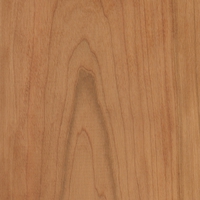 Cherry
CherryWood Database Entry for CherryColor/Appearance: Heartwood is a light pinkish brown when freshly cut, darkening to a medium reddish brown with time and upon exposure to light.Grain/Texture: The grain is usually straight and easy to work. Has a fine, even texture with moderate natural luster.Comments: Cherry develops a rich reddish-brown patina as it ages that's frequently imitated with wood stains on other hardwoods. This aging process can be accelerated by exposing the wood to direct sunlight.
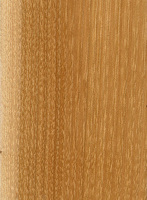
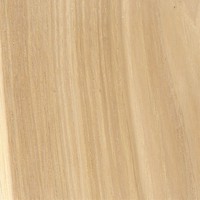 Hickory
HickoryWood Database Entry for HickoryColor/Appearance: Heartwood tends to be light to medium brown, with a reddish hue; sapwood is a paler yellowish brown. Boards with contrasting heartwood and sapwood create a somewhat rustic appearance.Grain/Texture: Grain is usually straight, though occasionally wavy, with a medium texture. Pores are medium-sized and open.Comments: Hickory is among the hardest and strongest of woods native to the United States.
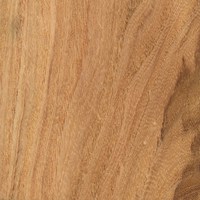 Honey Locust
Honey LocustWood Database Entry for Color/Appearance: Heartwood is a medium to light reddish brown. Wide sapwood is a light yellow, clearly distinguished from the heartwood.Grain/Texture: Grain is usually straight or slightly irregular, with a medium uneven texture. Moderate natural luster.
 Maple
MapleWood Database Entry for MapleColor/Appearance: Sapwood color ranges from nearly white, to an off-white cream color, sometimes with a reddish or golden hue. Grain/Texture: Grain is generally straight, but may be wavy. Has a fine, even texture.
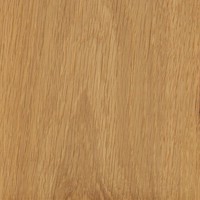
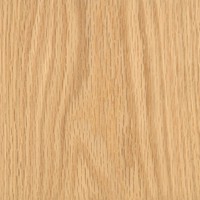 Oak
OakWood Database Entry for OakColor/Appearance: Heartwood is a light to medium brown, commonly with an olive cast (white oak) or a reddish cast (red oak). Grain/Texture: Grain is straight, with a coarse, uneven texture.Comments: Arguably the most popular hardwood in the United States, Red Oak is a ubiquitous sight in many homes.
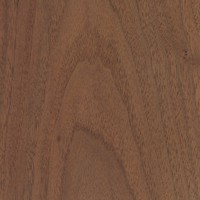 Black Walnut
Black WalnutWood Database Entry for Black WalnutColor/Appearance: Heartwood can range from a lighter pale brown to a dark chocolate brown with darker brown streaks. Color can sometimes have a grey, purple, or reddish cast.Grain/Texture: Grain is usually straight, but can be irregular. Has a medium texture and moderate natural luster.
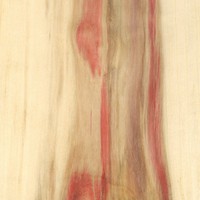 Box Elder
Box Elder
Wood Database Entry for Box Elder
Color/Appearance: Sapwood is a pale white, sometimes with a yellow/green hue. The heartwood is a grayish/yellowish brown, frequently with red or pink streaks. The red stain is produced by the tree's natural defenses when wounded.
Grain/Texture: Grain is straight, with a fine even texture. The growth rings are usually faint and non-distinct.
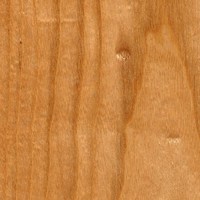 Kentucky Coffeetree
Kentucky Coffeetree
Wood Database Entry for Kentucky Coffeetree
Color/Appearance: Heartwood an orange to reddish brown. Overall appearance and grain pattern similar to ash or oak.
Grain/Texture: Grain is straight and porous, with a coarse, uneven texture.
Comments: So named because early settlers (particularly in the state of Kentucky) used roasted seeds from this tree to make a coffee substitute. Today, no such use is made of the tree’s seeds, but the wood is sometimes harvested and used for a variety of general construction purposes.
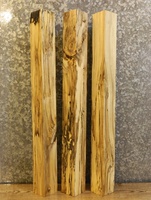 Spalted Hackberry
Spalted Hackberry
Wood Database Entry for Hackberry
Color/Appearance: Heartwood is light brown to gray. Wide sapwood is a contrasting light yellow. Susceptible to blue-gray fungal staining (spalting) if not processed promptly.
Grain/Texture: Grain is usually straight or occasionally slightly interlocked, with a very coarse uneven texture.
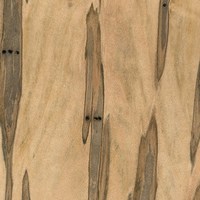 Ambrosia Maple
Ambrosia Maple
Wood Database Entry for Ambrosia Maple
Much like Spalted Maple and other forms of figured maple, Ambrosia Maple is technically not a specific species of Maple, but rather a general description of any type of Maple that has been infested by ambrosia beetles. The beetles bore into the tree, and with it bring fungus that discolors the wood.

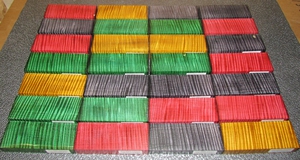 Curly Maple
Curly Maple
Wood Database Entry for Curly Maple
Curly Maple is not actually a species, but a description of a figure in the grain. It is so called because the ripples in the grain pattern create a three dimensional effect that appears as if the grain has “curled” along the length of the board. Other names for this phenomenon are: tiger maple, fiddleback maple, or flamed maple.
Commonly dyes can be added to emphasize the curl.
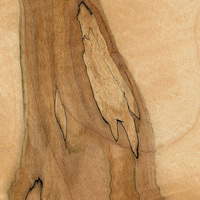 Spalted Maple
Spalted Maple
Wood Database Entry for Spalted Maple
Much like Ambrosia Maple and other forms of figured maple, Spalted Maple is technically not a specific species of Maple, but rather a general description of any type of Maple that has been allowed to begin initial stages of decay, and then subsequently dried (preventing further decay).
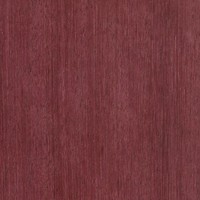 Purpleheart
Purpleheart
Wood Database Entry for Purpleheart
Color/Appearance: Upon exposure to light the wood becomes a deeper eggplant purple.
Grain/Texture: The grain is usually straight, but can also be wavy or irregular. Has a medium texture with good natural luster.
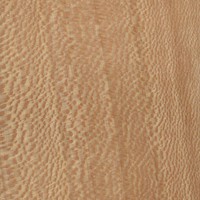 Sycamore
Sycamore
Wood Database Entry for Sycamore
Color/Appearance: Light tan to a darker reddish brown. Sycamore also has very distinct ray flecks present on quartersawn surfaces—giving it a freckled appearance—and it is sometimes even called “Lacewood.”
Grain/Texture: Sycamore has a fine and even texture that is very similar to maple. The grain is interlocked.
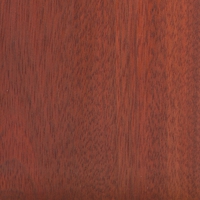 Bloodwood
Bloodwood
Wood Database Entry for Bloodwood
Color/Appearance: Heartwood is a bright, vivid red. Color can darken to a darker brownish red over time with exposure to light.
Grain/Texture: Grain is usually straight or slightly interlocked. Has a fine texture with good natural luster, and is also somewhat chatoyant.
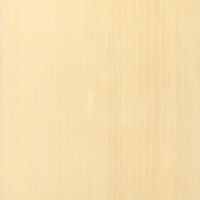 Holly
Holly
Wood Database Entry for Holly
Color/Appearance: Ideal lumber has a very uniform, pale white color with virtually no visible grain pattern.
Grain/Texture: Grain is interlocked and irregular. Medium to fine uniform texture with moderate natural luster.
Comments: Holly is typically used only for ornamental and decorative purposes such as inlay.
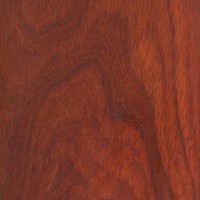 African Padauk
African Padauk
Wood Database Entry for African Padauk
Color/Appearance: Heartwood color can vary, ranging from a pale pinkish orange to a deep brownish red. Most pieces tend to start reddish orange when freshly cut.
Grain/Texture: Grain is usually straight, but can sometimes be interlocked. With a coarse, open texture and good natural luster.
Comments: The wood is sometimes referred to by the name Vermillion.
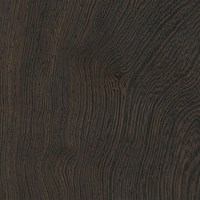 Wenge
Wenge
Wood Database Entry for Wenge
Color/Appearance: Heartwood is medium brown, sometimes with a reddish or yellowish hue, with nearly black streaks. Upon application of a wood finish (particularly an oil finish) the wood can become nearly black.
Grain/Texture: Grain is straight, with a very coarse texture. Low natural luster.
Comments: This wood is dark enough to be used as a substitute for ebony.
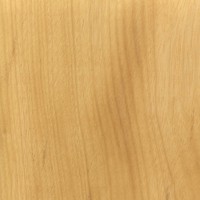
 Yellowheart
Yellowheart
Wood Database Entry for Yellowheart
Color/Appearance: Heartwood color ranges from pale to golden yellow, darkening only slightly with age.
Grain/Texture: Grain is usually straight, though some figured pieces may have wavy or interlocked grain. Fine uniform texture and a naturally high luster.
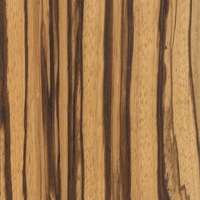
 Zebrawood
Zebrawood
Wood Database Entry for Zebrawood
Color/Appearance: Heartwood is a light brown or cream color with dark blackish brown streaks vaguely resembling a zebra’s stripes. Depending on whether the wood is flatsawn or quartersawn, the stripes can be either chaotic and wavy (flatsawn), or somewhat uniform (quartersawn).
Grain/Texture: Has a fairly coarse texture and open pores. Grain is usually wavy or interlocked.
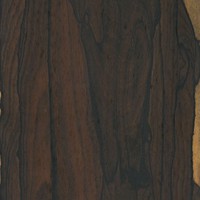 Ziricote
Ziricote
Wood Database Entry for Ziricote
Color/Appearance: Color ranges from medium to dark brown, sometimes with either a green or purple hue, with darker bands of black growth rings intermixed. Ziricote has a very unique appearance, which is sometimes referred to as “spider-webbing” or “landscape” grain figure. Quartersawn surfaces can also have ray flakes.
Grain/Texture: Grain is straight to slightly interlocked. Medium to fine texture, with good natural luster.
